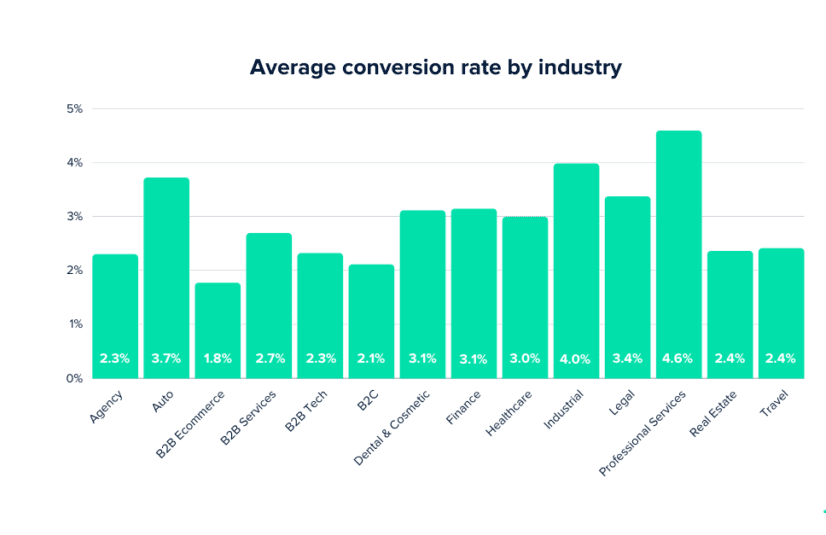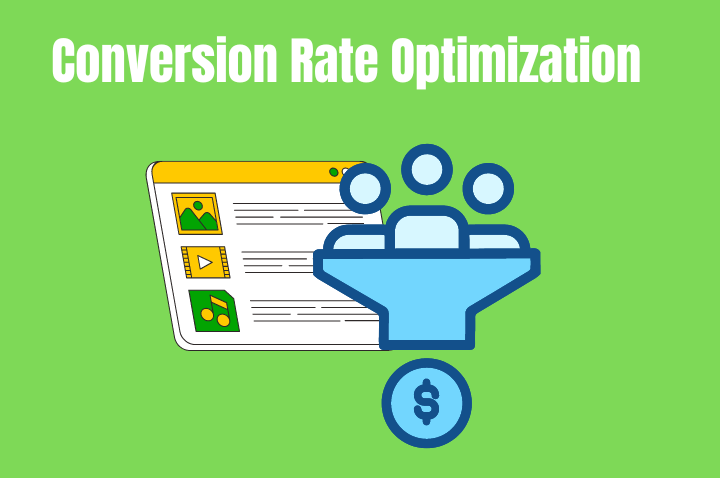Unlocking the full potential of an online business requires a CRO (Conversion Rate Optimization) audit. This essential process not only enhances website performance but also molds content to resonate with users on a deeper level. By delving into user behavior and refining key elements, businesses can optimize the conversion rate of a page and drive sustainable growth.
What Is A Conversion Rate Optimization?
Conversion Rate Optimization or CRO is the practice of enhancing your website or online platform to grow the percentage of visitors who take a preferred action, such as making a purchase or filling out a form.
It involves analyzing user behavior, making data-driven adjustments, and optimizing elements like design, content and calls to action. The goal is to create a seamless and persuasive user experience on a landing page that encourages more website conversions. By continually refining and optimizing your website, CRO strategy helps maximize the value you get from your existing traffic, ultimately driving business growth and success in the online space.
How to calculate the conversion rate?
Calculating the conversion rate is a straightforward process. Here’s a simple formula to follow:
- To calculate the conversion rate, you need to know two important numbers: the number of people who completed a desired action (let’s say purchases) and the total number of visitors to your website.
- Divide the number of purchases by the total number of visitors and multiply the result by 100. This will show you the conversion rate as a percentage.
For example, if you had 20 purchases out of 500 visitors, the calculation would be (20/500) * 100 = 4% conversion rate.
The conversion rate gives you a clear understanding of the effectiveness of your website in converting visitors into customers or achieving the desired action. By monitoring and improving this rate over time, you can make data-driven decisions to optimize your website and drive higher website conversions.
What average conversion rate by industry?

Image Source – Link
The bar graph provides insights into the average conversion rate benchmark across different industries, revealing that the overall average stands at 2.9%.
Interestingly, industries dealing with high-value products and services tend to have conversion rates lower than this average.
This can be attributed to the fact that purchasing decisions involving expensive items often lead to a longer and more intricate customer journey. Such variations in buyer behavior impact the conversion process, making it more complex and requiring businesses to adapt their strategies accordingly.
What audits should be performed for the CRO of a Website?
To maximize Conversion Rate Optimization (CRO) efforts, conducting various audits is crucial. Let’s explore each audit in detail:
-
Determine Traffic:
Assess the quality and sources of website traffic to understand its effectiveness and identify opportunities for improvement. This analysis helps in identifying channels that generate high-quality traffic, enabling businesses to focus their efforts on those channels for better website conversion rates.
-
Calculate Return on Investment (ROI):
By analyzing the revenue generated in relation to the costs invested in marketing campaigns, businesses can assess the profitability of their efforts. Calculating ROI helps optimize resource allocation and prioritize campaigns that provide the best returns, ultimately boosting conversions.
-
Ensure Accurate Tracking:
Implement reliable tracking mechanisms to collect accurate data on user interactions, conversions, and other key metrics. Accurate tracking ensures the integrity of data for analysis, allowing businesses to make informed decisions based on reliable insights.
-
Analyze Target Audience:
Gain a deep understanding of the target audience’s characteristics, preferences, and pain points. This analysis enables businesses to create tailored content and experiences that resonate with the target audience, increasing the likelihood of conversions.
-
Analyze User Behaviors:
Study user behavior patterns on the website, including navigation paths, engagement metrics, and conversion funnels. This analysis uncovers insights into user preferences, identifies friction points, and guides optimization efforts to enhance the user experience and increase conversions.
-
Assess Channel Traffic:
Evaluate the performance and effectiveness of different marketing channels (such as organic search, social media, and paid advertising) in driving traffic and conversions. This assessment helps businesses allocate marketing budgets wisely and optimize channels that deliver the highest quality traffic and conversions.
-
Perform Technical Analysis:
Conduct a thorough review of the landing pages and other important website technical elements, including page loading speed, mobile responsiveness, and site performance. Identifying and resolving technical issues ensures a smooth user experience, reduces bounce rates, and improves overall landing page conversion rates.
-
Understand what you offer, and how it will benefit them:
Clearly define and communicate the unique value proposition of your products or services. Highlighting key features and benefits in a compelling way helps visitors understand why they should choose your offerings, increasing the likelihood of conversion.
-
Convey trust and credibility to users:
Establish trustworthiness through elements such as customer testimonials, reviews, security seals, and transparent policies. Building trust enhances user confidence, reduces skepticism, and encourages conversions by conveying credibility and reliability.
What techniques should you follow after performing CRO audits?
Once you have performed CRO audits and identified areas for improvement, there are several techniques you can follow to further enhance conversion rates:
-
Conduct A/B Testing:
A/B testing involves creating two or more versions of a webpage or specific elements and comparing them to determine which performs better in terms of conversions. By systematically testing variations of headlines, calls-to-action, layouts, or other elements, you can gather data-driven insights to optimize your website and improve conversion rates.
-
Use Heatmaps:
Heatmaps are the most used conversion rate optimization tools that provide visual representations of user behavior on your website, showing where users click, scroll, or spend the most time. By analyzing heatmaps, you can identify hotspots of user engagement and areas of low interest or friction. This information helps you make informed decisions on optimizing the layout, content placement, and user flow to improve conversions.
-
User Recording:
User recording tools capture and analyze actual user sessions on your website. By reviewing recordings of user interactions, you can observe how users navigate, interact, and encounter any obstacles or usability issues. This qualitative data allows you to gain valuable insights into user behavior and make targeted improvements to enhance the user experience, ultimately leading to higher conversion rates.
By implementing these Conversion rate best practices, businesses can leverage data and user insights to make data-driven optimizations, improve the user experience, and ultimately drive more conversions on their websites.
Last But Not Least, Get Checks On:
In the pursuit of optimizing conversion, there are a few additional Conversion rate optimization tips that focus on areas that warrant attention:
-
Calls-to-Action (CTAs):
Your CTAs play a critical role in guiding users toward the desired action. Ensure that your CTAs are precise, compelling, and prominently positioned on your website. Test different variations, such as wording, design, or placement, to find the most effective CTAs that prompt users to take the desired action and increase conversions.
-
Streamline Navigation:
User-friendly and intuitive navigation is crucial for guiding visitors through your website and facilitating their journey toward conversion. Review your website’s navigation structure, menu labels, and hierarchy to ensure seamless navigation and easy access to relevant information. Simplify the user journey and minimize friction points to improve the overall user experience and increase the likelihood of conversions.
-
Scope for improvement in Landing pages:
Landing pages often serve as entry points for users and play a vital role in converting visitors into customers. Evaluate your landing pages to identify areas of improvement, such as optimizing headlines, enhancing the visual appeal, streamlining the form or checkout process, or aligning the content with user expectations. By continually refining and testing landing pages, you can increase their effectiveness in capturing leads or driving conversions.
By focusing on these aspects, businesses can fine-tune their website’s CTAs, streamline navigation for a seamless user experience, and optimize landing pages to maximize conversions. Taking a comprehensive approach to these areas will contribute to a more persuasive and conversion-oriented website.
Conclusion
In the ever-evolving landscape of online business, harnessing the power of Conversion Rate Optimization (CRO) audits is vital for sustained success. By conducting comprehensive CRO audits, businesses can unlock insights and opportunities to enhance their website’s performance and drive more conversions.
From analyzing user behaviors to calculating ROI and ensuring accurate tracking, each audit plays a crucial role in shaping effective strategies. By implementing the audits and taking data-driven actions, businesses can empower their online presence, foster trust with users, and ultimately achieve remarkable growth and success in the digital realm. Stay ahead of the competition, embrace the power of CRO audits, and watch your online business flourish.

